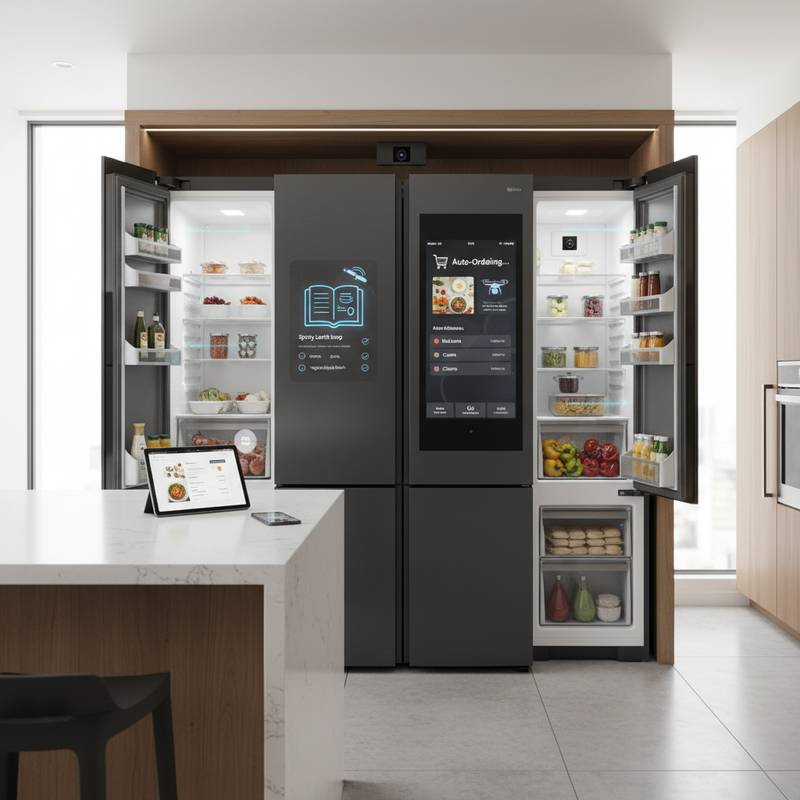Imagine opening your refrigerator after a long day and discovering it has already restocked the ingredients for tomorrow's dinner. No last-minute grocery runs occur, no items go forgotten, and no produce wastes away. Smart refrigerators capable of auto-ordering groceries based on recipes transform this vision into routine convenience for households. These appliances extend beyond cooling; they serve as intelligent assistants that enhance planning, shopping, and cooking efficiency.
Challenges in the Modern Kitchen
Work, family obligations, and daily tasks often make stocking the kitchen resemble a full-time responsibility. One might recall purchasing milk yet overlook the herbs needed for a preferred pasta dish. Alternatively, the refrigerator might contain assorted leftovers that fail to form a complete meal. While traditional grocery applications assist, they demand manual input. Smart refrigerators address this through integrated sensors, cameras, and recipe connections that automate pantry management.
How Auto-Ordering Functions
Contemporary smart refrigerators merge sophisticated inventory tracking with recipe-driven grocery procurement. Internal cameras monitor available items and consumption patterns. Barcode scanners and weight sensors detect low stock levels. Recipe software then proposes meals utilizing existing contents and places orders for absent ingredients via affiliated grocery providers.
For example, if the refrigerator identifies chicken and vegetables but lacks soy sauce, it incorporates that item into the subsequent delivery automatically. Certain models synchronize with preferred recipe applications to align meal recommendations with dietary needs and current inventory.
Step-by-Step Guide to Configuring Grocery Automation
- Connect the refrigerator to Wi-Fi and integrate it with a smart home system, such as Google Home, Amazon Alexa, or Samsung SmartThings.
- Establish grocery profiles by selecting favored stores or delivery options, including Walmart+, Instacart, or Amazon Fresh.
- Activate recipe integration within the companion application; the system adapts to cooking routines and preferred recipes.
- Initiate inventory monitoring, allowing cameras and sensors to observe refrigerator contents.
- Adjust auto-order parameters to regulate expenditure, delivery intervals, and substitution options.
After setup, the refrigerator assumes the burdensome aspects of meal preparation. Users retain oversight by approving orders through a smartphone prior to finalization, maintaining control without added tension.
Recommended Smart Refrigerator Models
Several smart refrigerators featuring grocery automation suit varying budgets.
- Budget-Friendly Model: LG Smart InstaView Refrigerator (approximately $1,999). It provides essential inventory monitoring and Alexa integration, though grocery orders necessitate manual approval.
- Mid-Range Option: Samsung Family Hub Refrigerator (approximately $3,499). Equipped with internal cameras, a touchscreen interface, and seamless connections to delivery services, it generates recipe ideas from available items and replenishes staples autonomously.
- High-End Choice: Bosch Series 800 Smart Refrigerator (approximately $4,999). This unit incorporates precise sensors, energy conservation, and an AI framework that adapts to culinary behaviors. Integration with Home Connect facilitates recipe-based grocery handling.
Each model supports prominent smart home ecosystems. When selecting, prioritize extended software updates and alignment with delivery preferences. Brands with upgradable firmware sustain features over multiple years.
Key Factors for Purchase Decisions
Acquiring a smart refrigerator with auto-ordering capabilities demands thoughtful evaluation. Measure kitchen dimensions and verify electrical specifications first. These units require reliable Wi-Fi; install a mesh network if signal strength proves inadequate in the kitchen area.
Anticipate costs ranging from $2,000 to $5,000 based on dimensions and features. Premium recipe resources or delivery subscriptions may incur additional fees. Despite the initial investment surpassing conventional models, benefits in convenience and waste reduction frequently justify the expense.
Self-installation suits basic connections, yet professional assistance for delivery and alignment optimizes functionality. For units linked to water lines serving ice or beverage features, engage a certified plumber to uphold safety and warranty terms.
Enhancing Meals Through Data Insights
These refrigerators extend beyond mere reordering by examining consumption trends longitudinally. If spinach purchases recur but portions spoil routinely, the system diminishes future quantities proactively. Such forecasts curb waste and conserve funds. Advanced variants compute nutritional profiles from scanned goods, aiding calorie monitoring and meal balance.
Addressing Privacy and Security
Household data collection by these devices necessitates vigilance on privacy. Employ password-secured Wi-Fi and enable two-factor authentication for associated accounts. Established manufacturers secure transmissions through encryption and obscure usage data, yet scrutinize application privacy controls. Refrain from linking to unprotected public networks.
Integrating Automation into Daily Routines
To elevate the kitchen into a cohesive, tech-enabled environment, pinpoint essential needs: convenience, nutrition oversight, or recipe sophistication. Explore certified installers via reputable home improvement platforms for guidance on Wi-Fi-enabled appliances.
Smart refrigerators auto-ordering recipe ingredients evolve from conceptual innovations to essential aids. They streamline routines, diminish waste, and restore enjoyment in cooking absent procurement worries. Properly selected and installed, they position the kitchen as a collaborative, intelligent domain within the home.
Frequently Asked Questions
What if the auto-order selects incorrect substitutions? Most systems permit pre-order reviews and customization of preferences, such as brand loyalties or allergen avoidance, ensuring alignment with needs.
Do these fridges work offline? Core functions like cooling persist without internet, but inventory tracking and ordering require connectivity; a stable Wi-Fi setup proves essential.
How accurate is the inventory tracking? Cameras and sensors achieve high precision for packaged goods, though fresh produce recognition improves with software updates and user input.
